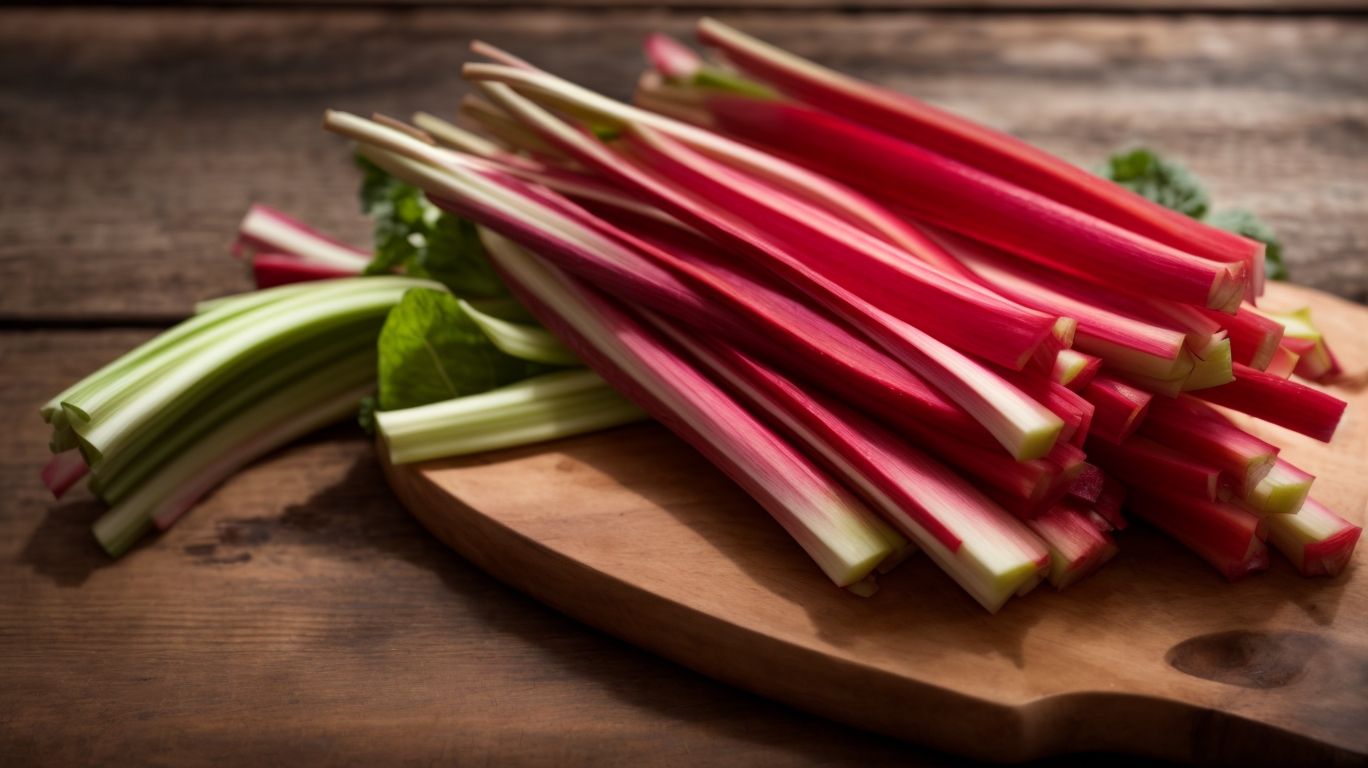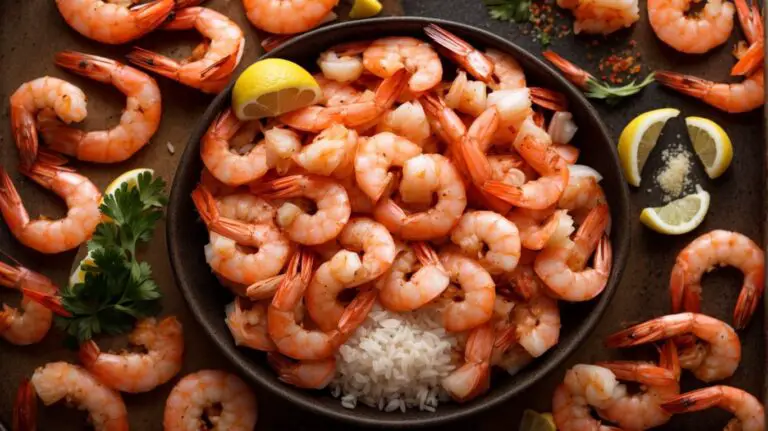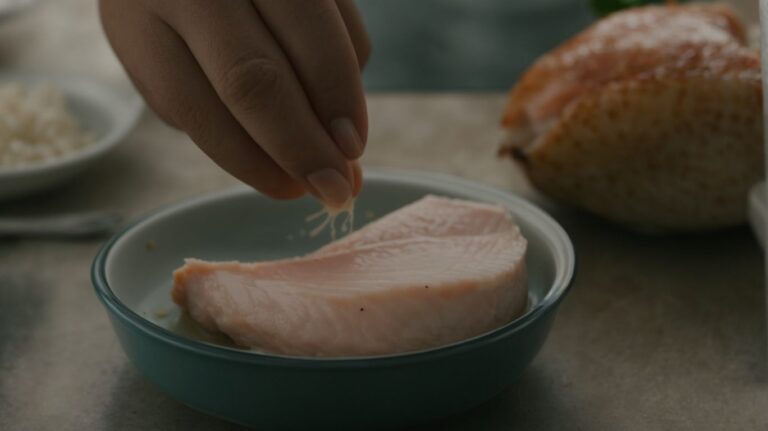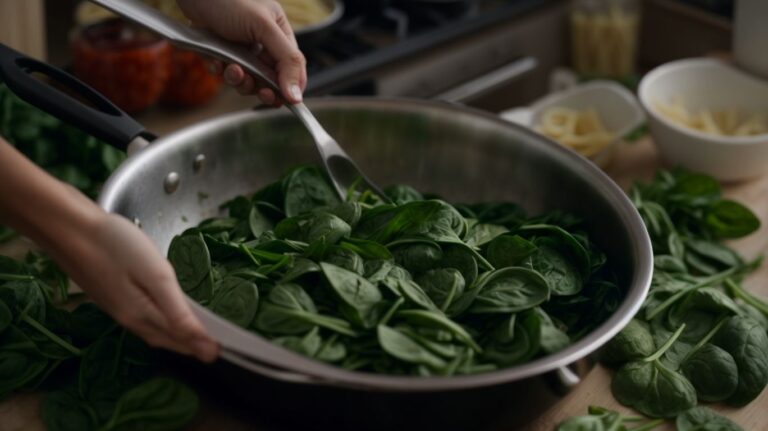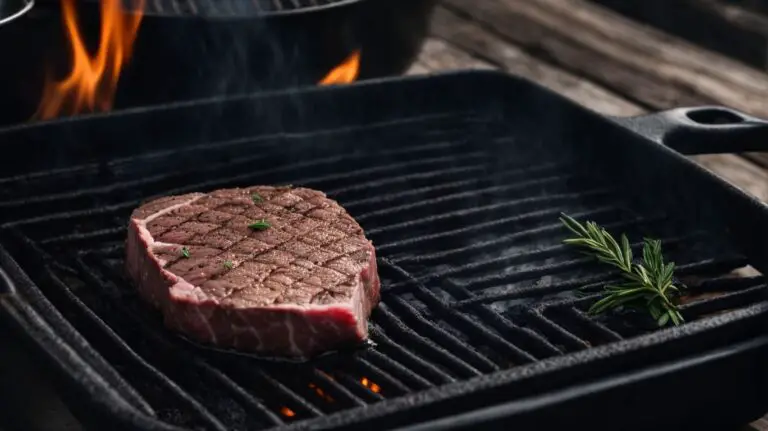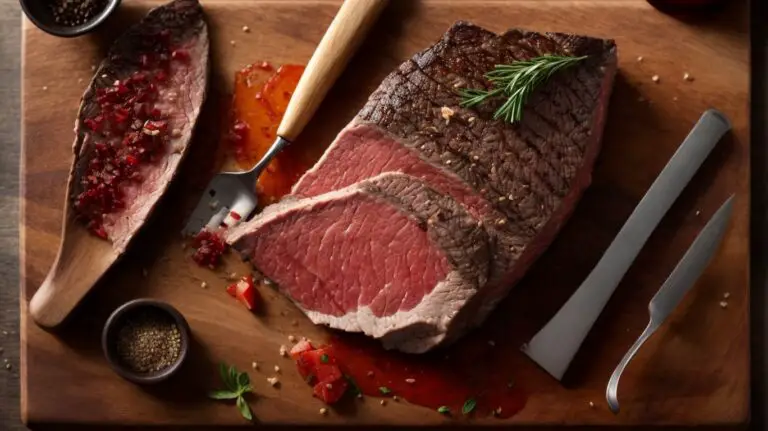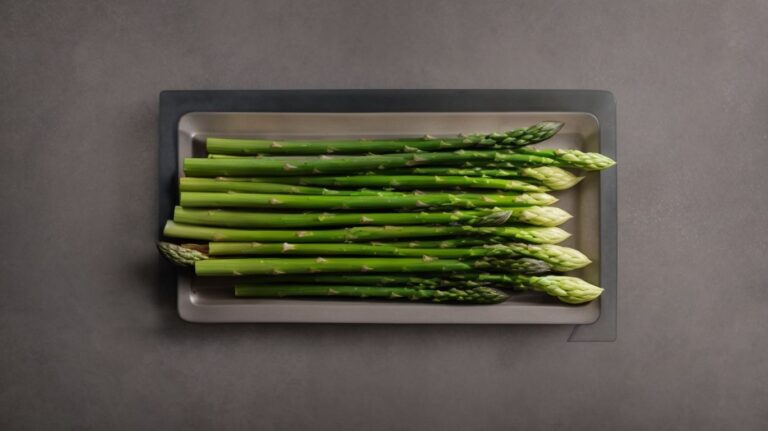How to Cook Rhubarb?
Are you looking to add a unique and tangy flavor to your dishes?
Look no further than rhubarb!
In this comprehensive guide, we will explore everything you need to know about rhubarb – from its taste and nutritional benefits to how to choose, store, and prepare it for cooking.
We will also dive into popular ways to cook rhubarb, along with tips and tricks for balancing its tartness and incorporating it into savory dishes.
Let’s get cooking with rhubarb!
Key Takeaways:
What is Rhubarb?
Rhubarb, a plant known for its tart taste, is a versatile ingredient in cooking and baking.
Known scientifically as Rheum rhabarbarum, rhubarb belongs to the buckwheat family and is primarily cultivated for its thick, edible stalks. These stalks, which are the only safe-to-eat part of the plant due to the toxicity of the leaves, are commonly used in a variety of sweet and savory dishes.
Rhubarb’s distinctive sharp flavor adds a tangy kick to pies, jams, sauces, and even cocktails. Due to its sourness, it is often paired with sweet fruits or sugar to balance out its taste.
What Does Rhubarb Taste Like?
The taste of rhubarb is a unique combination of tartness and sweetness, making it a distinctive flavor in culinary creations.
When you bite into a rhubarb stalk, you are greeted with a sharp tanginess that is quickly followed by a subtle underlying sweetness, creating a delightful contrast on your palate. This complex flavor profile makes rhubarb a versatile ingredient that can be used in both sweet and savory dishes. The tartness of rhubarb pairs exceptionally well with sugar, resulting in heavenly desserts like rhubarb pie and rhubarb crumble.
Its unique taste can also be harnessed in savory dishes, such as chutneys, sauces, and even as a glaze for meats. The versatility of rhubarb in the culinary world is truly remarkable, offering a burst of flavor that is hard to replicate with any other ingredient.
What Are the Nutritional Benefits of Rhubarb?
Rhubarb offers a range of nutritional benefits, including being rich in vitamins, minerals, and antioxidants.
One key advantage of consuming rhubarb is its high vitamin K content, essential for blood clotting and bone health. Its antioxidant properties help combat free radicals, reducing the risk of chronic diseases. Rhubarb is also a good source of vitamin C, promoting a healthy immune system. The fiber in rhubarb supports digestive health and can aid in weight management. The unique blend of nutrients in rhubarb makes it a valuable addition to a balanced diet.
Choosing and Storing Rhubarb
Selecting and storing rhubarb properly is essential to ensure its freshness and flavor in culinary preparations.
How to Select Fresh Rhubarb?
When choosing fresh rhubarb, look for firm stalks with vibrant color and crisp texture to ensure optimal taste and quality in your dishes.
Inspect the rhubarb stalks closely, making sure there are no blemishes or soft spots, as these are signs of aging. Gently squeeze the stalks; they should feel firm and have a slight give when pressed. Avoid stalks that are limp or rubbery, as they may be past their prime.
Another important factor to consider is the color of the rhubarb. Seek out stalks that have a deep, rich hue, signaling freshness and flavor. Fresher rhubarb will also have taut, glossy skin without any wrinkling, indicating it was recently harvested.
How to Store Rhubarb?
To store rhubarb, wrap the stalks in a damp paper towel and place them in a perforated plastic bag in the refrigerator to maintain their freshness and crispness.
It is important to ensure that the rhubarb is stored in the refrigerator at a consistent temperature of around 32 to 40°F (0 to 4°C) to prevent wilting and decay. Proper humidity levels are also crucial for preserving rhubarb; storing it in a high-humidity environment or using a crisper drawer can help maintain its juiciness. When stored correctly, rhubarb can last for up to two weeks, retaining its flavor and texture for longer periods.
Preparing Rhubarb for Cooking
Properly preparing rhubarb for cooking involves washing, trimming, and cutting the stalks to enhance their texture and flavor in various recipes.
How to Wash and Trim Rhubarb?
Before cooking with rhubarb, wash the stalks thoroughly under running water and trim the ends to remove any tough or fibrous sections for optimal culinary results.
Properly washing and trimming rhubarb is crucial to ensure its flavor shines through in your dishes. To start, fill a bowl or sink with cold water and immerse the rhubarb stalks, gently swishing them around to dislodge any dirt or debris. Next, place the stalks under running water to give them a final rinse.
Regarding trimming, using a sharp knife, cut off the ends of the stalks where they appear dried out or discolored. Trimming these sections not only enhances the visual appeal but also improves the texture of the cooked rhubarb.
How to Cut Rhubarb?
When cutting rhubarb for recipes, slice the stalks into uniform pieces or dice them according to the dish’s requirements to ensure even cooking and consistent texture.
For slicing, start by washing the rhubarb stalks thoroughly and removing any tough strings. Then, using a sharp knife, cut the stalks into even slices of the desired thickness. This method works well for pies, tarts, and compotes where the rhubarb needs to hold its shape.
On the other hand, for dicing, you can neatly cut the rhubarb into small cubes or rectangles, which are perfect for jams, sauces, and chutneys. Ensure to maintain a similar size for all the pieces to promote uniform cooking and enhance the dish’s presentation.
Popular Ways to Cook Rhubarb
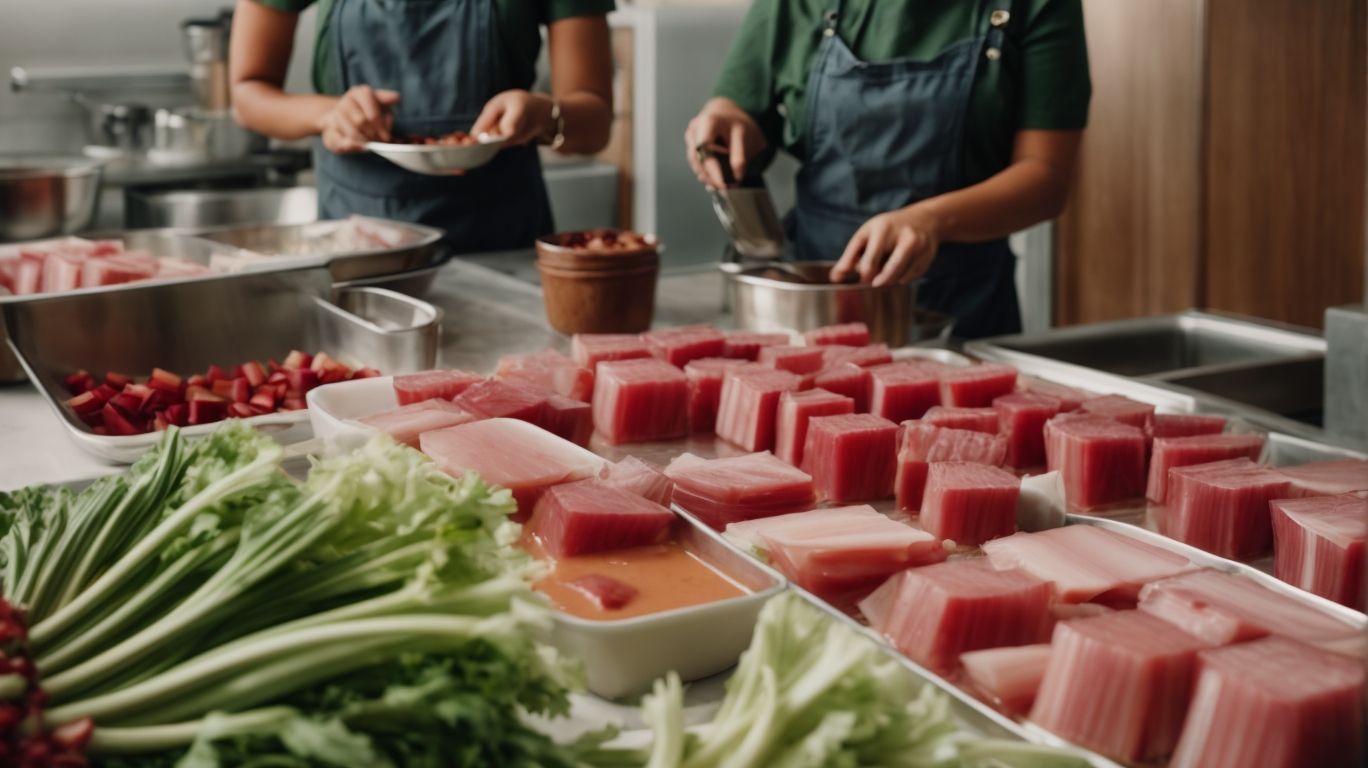
Credits: Poormet.Com – Randy Jackson
Explore a variety of popular ways to cook rhubarb, including making compote, crisps, pies, jams, and other delightful treats that showcase its unique flavor.
Rhubarb Compote
Rhubarb compote is a simple and versatile recipe that combines stewed rhubarb with sugar and spices, perfect for serving over yogurt, ice cream, or pancakes.
It is a delightful way to enjoy the tartness of rhubarb in a sweet and tangy treat. To make this compote, start by chopping fresh rhubarb into small pieces, ensuring they are uniform for even cooking. Combine the rhubarb with a generous amount of sugar in a saucepan over medium heat, allowing the mixture to simmer until the rhubarb softens and releases its juices, forming a luscious syrup.
Adding a splash of water during the cooking process can help prevent the rhubarb from sticking to the pan. To enhance the flavor, consider incorporating cinnamon or citrus zest for a fragrant twist. Once the rhubarb reaches a jam-like consistency, remove it from the heat and let it cool before transferring it to a jar for storage.
This compote is a versatile condiment that can be used in various ways – try spooning it over Greek yogurt for a breakfast parfait, swirling it into vanilla ice cream for a refreshing dessert, or drizzling it over fluffy pancakes for a sweet brunch treat. The possibilities are endless, and the bright pink hue of the rhubarb compote adds a vibrant touch to any dish it accompanies.
Rhubarb Crisp
A rhubarb crisp is a delightful dessert that combines stewed rhubarb with a crispy oat topping, creating a perfect balance of sweet and tart flavors.
For those looking to make their own rhubarb crisp, the process is quite simple and rewarding. Here’s a step-by-step guide to help you create this delicious treat:
- Start by preheating your oven to 350°F to ensure it’s at the right temperature for baking.
- Prepare the rhubarb filling by chopping fresh rhubarb into small pieces and mixing it with sugar and a hint of cinnamon for extra flavor.
- Next, combine oats, flour, brown sugar, and butter to create a crumbly topping that will go over the rhubarb mixture.
Rhubarb Pie
Rhubarb pie is a classic dessert that showcases the tangy flavor of rhubarb in a flaky crust, often paired with sweet fruits like strawberries for a delicious contrast.
Regarding making a rhubarb pie, the first step is to prepare the pastry. This involves combining flour, butter, a pinch of salt, and cold water to create a dough that is both tender and crispy.
For the filling, rhubarb is usually mixed with sugar to balance its tartness and enhance its natural sweetness. Some recipes also call for a hint of cinnamon or ginger to add depth to the flavor profile.
Once the pastry and filling are ready, they are carefully assembled in a pie dish, with the top crust usually adorned with decorative vents or lattice patterns for both aesthetic appeal and proper airflow during baking.
Rhubarb Jam
Homemade rhubarb jam is a delightful spread that captures the fresh essence of rhubarb, ideal for pairing with toast, muffins, or scones.
Preserving the tangy sweetness of rhubarb through making jam at home is a rewarding process that allows you to savor the flavors of the season all year round. Adjusting the sugar content in the jam recipe can tailor the sweetness levels to your preference, whether you enjoy a more tart or sweet outcome. The vibrant pink hue of rhubarb jam adds a pop of color to your pantry shelves, making it a visually appealing homemade treat that also makes for delightful gifts during special occasions.
Roasted Rhubarb
Roasted rhubarb offers a unique twist on this versatile ingredient, bringing out its natural sweetness and enhancing its texture through caramelization.
When preparing roasted rhubarb, it’s essential to start with fresh, firm stalks. Begin by preheating your oven to 375°F (190°C) and washing the rhubarb thoroughly. Next, trim the ends and cut the rhubarb into evenly sized pieces to ensure even cooking. Seasoning is a crucial step; you can opt for classic flavors like vanilla bean, cinnamon, or orange zest to complement the tartness of the rhubarb. Arrange the rhubarb in a single layer on a baking sheet, drizzle with honey or maple syrup, and add a sprinkle of brown sugar for extra caramelization.
Regarding the cooking method, roasting is preferred to maintain the rhubarb’s shape and color. Roast the rhubarb in the preheated oven for about 15-20 minutes, or until it softens slightly but still holds its shape. Remember to turn the rhubarb halfway through the cooking process for even caramelization.
Once the roasted rhubarb is done, let it cool slightly before serving. This delectable treat can be enjoyed warm or cold, making it a versatile addition to desserts, breakfast dishes, or as a topping for yogurt or ice cream. The soft, caramelized texture paired with the sweet-tart flavor of the rhubarb is sure to delight your taste buds.
Rhubarb Sauce
Rhubarb sauce is a versatile condiment that complements both sweet and savory dishes, adding a tangy and vibrant flavor to your culinary creations.
When making rhubarb sauce, the key is to balance the tartness of the rhubarb with a sweetener like sugar or honey. You can also enhance the flavor by adding spices such as ginger or cinnamon. To prepare the sauce, simply chop the rhubarb stalks into small pieces and cook them down with your choice of sweetener and spices in a saucepan over medium heat until the rhubarb breaks down and becomes soft.
Rhubarb Chutney
Rhubarb chutney is a delightful condiment that blends the tangy notes of rhubarb with aromatic spices, perfect for accompanying cheeses, meats, or sandwiches.
One of the key elements in making a flavorful rhubarb chutney is the combination of ingredients. Aside from the star ingredient, rhubarb, you will need sugar to balance its tartness, a hint of ginger for warmth, and a touch of vinegar for a tangy kick. The cooking process involves simmering these components together until they form a thick, sweet-sour sauce. This chutney can be enjoyed immediately while warm, but it also develops its flavors beautifully when allowed to cool and mature for a day or two.
Rhubarb Cake
Rhubarb cake is a moist and flavorful dessert that incorporates diced rhubarb into a tender cake batter, creating a delightful treat for any occasion.
When preparing a rhubarb cake, it’s essential to ensure the rhubarb pieces are evenly distributed throughout the batter to guarantee a burst of tangy flavor in every bite. Preparing the rhubarb by tossing it in a bit of flour before folding it into the batter helps prevent it from sinking to the bottom of the cake during baking. To enhance the flavor profile, consider adding a hint of cinnamon or ginger to complement the tartness of the rhubarb.
Once the rhubarb cake is baked to perfection and cooled, you can opt for a simple dusting of powdered sugar on top for a classic finish, or get creative with a drizzle of cream cheese glaze or a dollop of whipped cream. Fresh mint leaves and additional sliced rhubarb make for elegant garnishes, adding a pop of color and freshness to your presentation.
Rhubarb Bread
Rhubarb bread is a deliciously moist and aromatic treat that combines chopped rhubarb with a blend of spices and nuts, perfect for breakfast or snacking.
Adding rhubarb to a bread recipe creates a unique twist that surprises your taste buds. The tartness of the rhubarb complements the sweetness of the bread, creating a perfect balance of flavors.
To enhance the texture, you can opt for whole wheat flour or add a variety of nuts like walnuts or pecans. Including spices such as cinnamon or nutmeg can elevate the aroma and taste profile of the bread.
Serve this delightful treat warm with a dollop of whipped cream or enjoy it with a cup of tea for a comforting indulgence.
Rhubarb Muffins
Rhubarb muffins are a delightful breakfast or snack option that combines the tangy flavor of rhubarb with a moist and tender muffin base, perfect for on-the-go indulgence.
If you’re looking to make these muffins at home, start by preheating your oven to 375°F (190°C) and preparing a muffin tin with liners.
In a large mixing bowl, combine flour, sugar, baking powder, and salt. For a twist on the classic recipe, consider adding a sprinkle of cinnamon or a hint of orange zest to elevate the flavors. Whisk in eggs, milk, and melted butter until just combined – be careful not to overmix. Fold in the chopped rhubarb gently to distribute it throughout the batter.
Tips and Tricks for Cooking with Rhubarb
Enhance your culinary creations with rhubarb by mastering essential tips and tricks for cooking with this versatile ingredient.
How to Balance the Tartness of Rhubarb?
To balance the tartness of rhubarb in your dishes, consider adding complementary sweeteners like sugar, honey, or fruit to achieve a harmonious flavor profile.
Another effective way to adjust the tartness of rhubarb is by incorporating ingredients with natural acidity, such as citrus juices or vinegar, which can help counterbalance the sharpness with a touch of brightness.
Experimenting with spices like cinnamon, ginger, or vanilla can provide depth and complexity, enhancing the overall taste of your rhubarb creations.
What Ingredients Pair Well with Rhubarb?
Rhubarb pairs exceptionally well with ingredients such as strawberries, cinnamon, vanilla ice cream, and oats, creating delicious flavor combinations in various dishes.
These ingredient pairings harmonize the tartness of rhubarb with sweetness and warmth. For a classic rhubarb-strawberry pie, the sweetness of strawberries balances the tartness of rhubarb beautifully. Adding a touch of cinnamon enhances the flavors, elevating the dish to a new level of deliciousness.
Combining rhubarb with vanilla ice cream showcases a contrast of temperatures and textures, as the cool creaminess complements the warm, tangy rhubarb. Sprinkling oats on top of a rhubarb crumble adds a nutty crunch that enhances both the taste and presentation of the dessert.
How to Use Rhubarb in Savory Dishes?
Incorporate rhubarb into savory dishes by adding it to sauces, glazes, salads, or marinades to introduce a tangy and refreshing element to your culinary creations.
For a versatile approach, try making a rhubarb chutney to accompany roasted meats, adding a sweet yet sharp contrast. Rhubarb can also be pickled to create a unique condiment for cheese platters or charcuterie boards. Experiment with rhubarb salsa as a topping for grilled fish or tacos, enhancing the flavors with its bold acidity.
You can bake rhubarb alongside savory ingredients like chicken or pork, infusing the dish with a subtle tartness. Blend cooked rhubarb into soups for a surprising twist or use it to add depth to curry dishes, balancing out the richness with its distinctive zing.
Conclusion
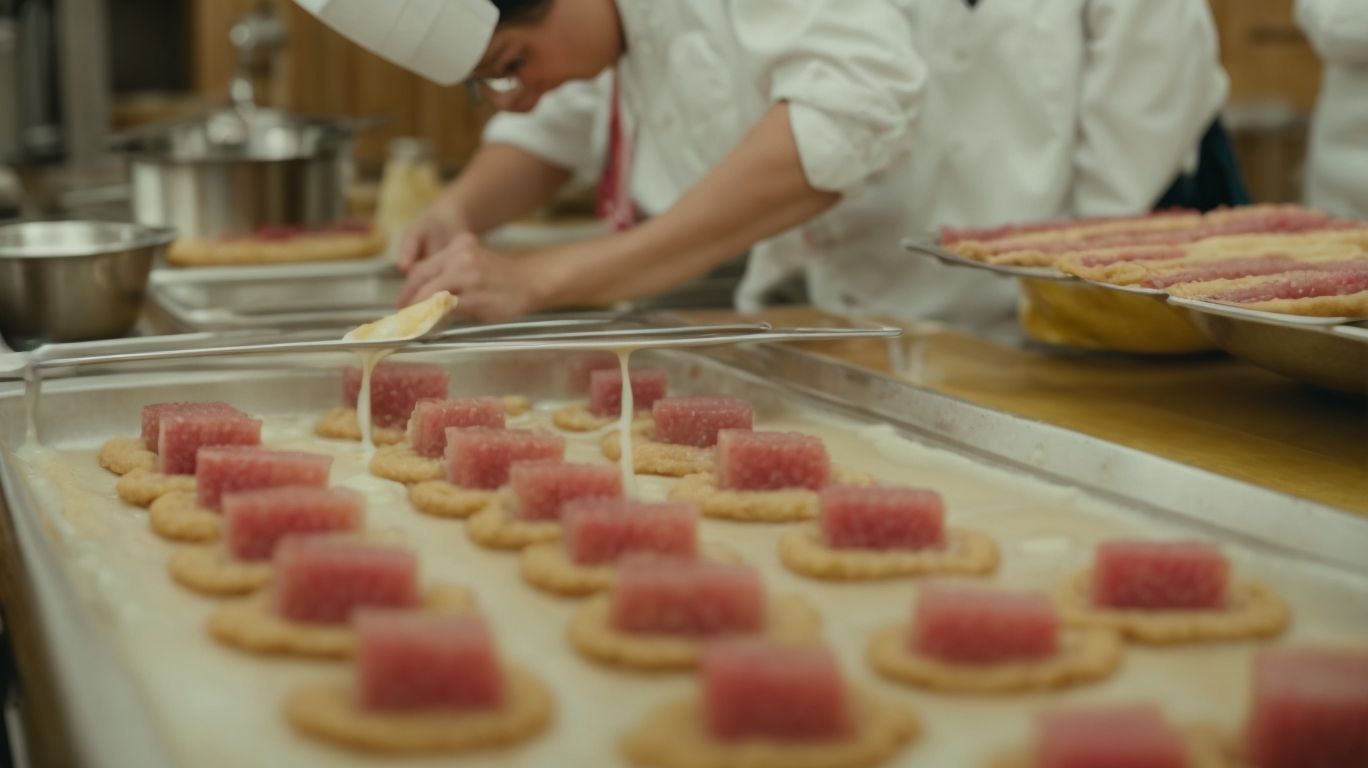
Credits: Poormet.Com – Keith Williams
In conclusion, rhubarb’s versatile nature and distinctive flavor make it a prized ingredient in both sweet and savory dishes, offering endless culinary possibilities for creative cooks.
Rhubarb, with its long stalks and vibrant red hue, is often described as having a tart flavor that pairs well with sweet ingredients like strawberries or sugar to create a balanced and delicious taste.
Its versatility shines through in dishes ranging from pies and crumbles to sauces and chutneys, adding a refreshing tangy note that cuts through rich flavors.
Not only is rhubarb a popular choice for desserts, but it also lends itself well to savory dishes such as roasts, marinades, and even pickles, showcasing its ability to elevate a wide range of culinary creations.
Frequently Asked Questions
How to Cook Rhubarb?
What is the best way to cook rhubarb?
The best way to cook rhubarb is to lightly stew it on the stovetop with a bit of water and sugar until it becomes soft and slightly caramelized.
Can I eat rhubarb raw?
While rhubarb can be eaten raw, it is quite tart and can be tough to chew. It is best to cook rhubarb before consuming it.
How do I prepare rhubarb for cooking?
Start by washing the stalks and trimming off the ends. You can also peel off any tough strings if desired. Then, cut the stalks into small pieces to make them easier to cook.
Tips for Cooking Rhubarb
How do I know when rhubarb is cooked?
When cooking rhubarb, you will know it is done when the pieces are soft and easily pierced with a fork. The color will also change from green to a deeper shade of red.
Can I freeze rhubarb?
Yes, you can freeze rhubarb for later use. Simply wash and chop it into pieces, then place in an airtight container or freezer bag. It can last for up to a year in the freezer.
Are there any other ways to cook rhubarb?
Yes, rhubarb can also be used in dishes such as pies, crumbles, and cakes. It pairs well with other fruits like strawberries and apples, as well as in savory dishes like chutneys and sauces. The possibilities are endless!

